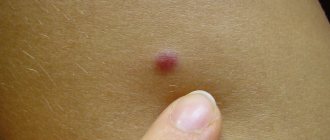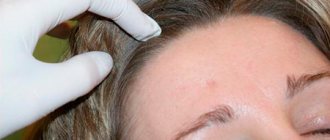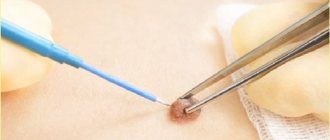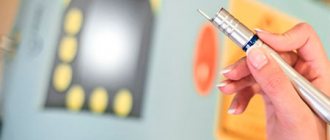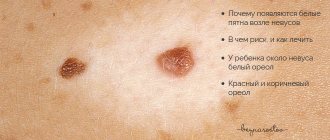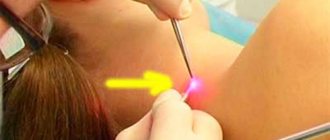Last Updated on 05.10.2016 by
If, after removing a mole with a laser, a dark spot appears on the skin, then this publication will come in very handy, as you will learn about the possible reasons for its formation and methods for its removal. It is known that moles bring a lot of physical and aesthetic inconvenience. That is why it is completely justified to remove them. Today, there are several ways to eliminate a mole or wart. Among them I would like to highlight the following:
- cryodestruction;
- laser removal;
- radiocoagulation;
- surgical intervention.
Taking into account the fact that some of these techniques are painful and can have a long recovery period, it is safe to say that the best method of removal is laser correction.
Brown dot - what is it?
Sometimes, some time after the mole has been successfully removed and the skin has healed, a dot appears in the same place. Most likely, such a spot is a symptom of a relapse - the reappearance of a nevus. It may take 1-2 months from the moment of surgical removal to the visual appearance of a new mole, sometimes more.
When you carefully examine the brown spot that appears at the site of the removed mole, under a microscope you can see cells that are typical for all moles. They are capable of producing a brown pigment known as melanin. It is thanks to him that the nevus turns brown.
What may cause the appearance of a tubercle?
Sometimes it seems that a new mole has appeared due to tissue swelling as a result of damage to the lymphatic vessel during excision of the nevus. Usually their condition recovers within a few days. If an infection gets into the wound, an inflammatory process may begin, accompanied by an increase in temperature to 39 °C or more. To eliminate it, antibiotics are prescribed.
A dense tubercle may also grow if the removed nevus has degenerated into a malignant tumor. In this case, examination and treatment by an oncologist is necessary. If necessary, a new operation is performed. The nature of the neoplasm can be confirmed by histological examination of its tissues.
It also happens that the mole has grown due to the fact that during the operation the deeply located melanocyte cells that make up the nevus were not removed.
As they grew, they caused pigmentation to appear in the same place. The reason for incomplete removal of mole tissue is sometimes the choice of an insufficiently effective procedure method - the use of laser radiation, cryodestruction. To correct the error, the spot is re-excised using a scalpel. Not only the tissue of the mole is cut out, but also the adjacent layers of the epidermis are captured at a short distance (3–4 mm). After healing, a scar may remain at the surgical site.
Why did it appear again?
The main reason for the reappearance of a mole after removal lies in the insufficient quality of surgical intervention. If a previously existing nevus was not completely removed, part of its cells (a microscopic fraction is enough) will remain in the skin, and after some time will begin to produce brown pigment.
However, some doctors claim that even when a mole is removed, including a significant amount of healthy surrounding tissue, there is a risk of relapse. In this case, it is not yet possible to determine its causes.
Treatment with folk remedies
There are several methods for treating moles using traditional medicine and medicinal plants. These recipes can be used only with the permission of a doctor and only if the mole does not pose a danger to humans. That is, it did not turn into melanoma.
One of the most famous methods in this direction is a compress on a mole made from grated garlic and lemon. It is believed that daily use of this remedy will make the mole disappear within a week.
Another compress is baking soda with castor oil. The preparation is simple - castor oil and soda are mixed in equal proportions until a homogeneous mass is obtained. Apply to the mole for 5 days, and for 10-12 hours. After this, the neoplasm resolves.
You can tie a fresh cut of celandine to the mole, having previously smeared it with the juice of this plant.
What to do if it is not completely removed?
If some time after the mole was removed, it suddenly grows back, do not panic. The first thing you need to remember is how the nevus was eliminated. If it was removed according to all the rules with a histological examination of the tissues, and the tests did not find any pathological (cancerous cells), you can calm down and not worry. Of course, it would be a good idea to show a new (recurrent) mole to a doctor and make sure it is safe.
When is pigmentation dangerous?
A benign nevus, which for some reason appears again, is considered a benign phenomenon. However, there are typical symptoms that require special attention. They are, in principle, similar to similar signs of malignancy of any mole and include:
- Increase in size. If a new nevus grows before your eyes, you should immediately show it to a dermatologist-oncologist.
- Ulceration (appearance of cracks, erosions on the surface of the nevus).
- Bleeding.
- Soreness.
- Permanent injury.
It is worth noting that the risk of developing melanoma after incomplete removal of a benign mole is quite small. Nevertheless, this possibility is worth considering.
Recurrence of dysplastic nevus
Dysplastic nevus has an increased tendency to malignancy. Such a mole can have different sizes, bizarre borders and heterogeneous coloring. Sometimes it rises above the skin level. Doctors strongly recommend removing such single moles with mandatory histological examination. But even after surgical resection, they can appear again, which is considered a rather alarming symptom.
If a dysplastic nevus recurs, it is better not to hesitate and go to the office of a dermatologist-oncologist. Most likely, such a mole will need to be excised again, followed by a comprehensive examination.
What if there was no histology?
If the nevus was removed in a regular beauty salon or evaporated by a laser (electric current, etc.) without a histological analysis, there is already something to worry about. After all, there is a high risk that malignant processes of degeneration have already begun in the removed mole, and accordingly, the tumor may continue to develop. Moreover, the time for timely diagnosis and early treatment may already be lost. Tumors that develop in the skin after a mole is removed can grow especially quickly and metastasize.
If the nevus recurs, it is best to remove it again and conduct a histological examination. Only in this case will you be able to remain calm about your health.
Causes of blackheads
Typically, blackheads appear for the following reasons:
- Physical and mechanical damage to the mole. Basically, nevi have the shape of a hemisphere, slightly raised above the surface of the skin; accordingly, the formation is most easily touched by clothing, a nail or other object. Moles are much more sensitive to pain than ordinary skin, so a person notices such an injury immediately.
- Effect of solar ultraviolet radiation. Such radiation is dangerous for the body, especially for the skin. The process of the appearance of blackheads is quite simply explained. This is a protective reaction of the body associated with increased accumulation of melanin in the area with the mole.
Repeated excision
Usually, to remove a recurrent mole, doctors resort to excision of such a formation with a scalpel. It is believed that this method allows one to reliably eliminate all nevus cells, capturing the surrounding healthy skin, and also obtain suitable material for histological examination. Of course, using a scalpel is considered a rather traumatic method of removal, and it leaves scars on the skin.
In some cases, it is possible to remove a mole using a laser, electric current or radio wave method. But at the same time, the doctor should not evaporate the nevus, but cut it off in order to again obtain material for histological analysis.
Removal at home
Do not try to get rid of nevi on your own. Such “operations” often lead to serious consequences.
Only hanging moles can be removed at home. There are different methods for getting rid of such nevi:
- Rubbing a mole with pineapple juice.
- Vaseline will also help. They need to lubricate the nevus.
- Is it possible to remove a mole on the face with celandine? To get rid of a nevus, it is recommended to wipe it with the juice of the above-mentioned plant.
Remember that it is absolutely not recommended to remove moles at home! It is better to consult a doctor first.
The red spot does not go away
Sometimes, even after successful removal of a mole by laser or other methods, a red or pinkish spot remains on the skin, which is not a recurrence of the nevus. This mark may appear:
- If the skin healing process is still ongoing. It may take about six months or even more until the color of the epidermis is completely evened out.
- Soon after the crust falls off. In this case, a pinkish spot is observed on the skin - an area of young, delicate epidermis.
- If you tear off the crust ahead of time (accidentally or intentionally). Such a dark spot at the site of a removed mole can remain for life; to get rid of it, you must definitely use means to activate regenerative processes (silicone ointments and patches, Contractubex, Solcoseryl, etc.).
- With improper skin care. In particular, reddish spots may appear when the young epidermis is exposed to sunlight. In this case, they indicate a skin burn and can subsequently lead to pigmentation of such an area.
- Due to the penetration of infectious agents. In this case, the problem area may swell, itch, and even be noticeably painful. The formation of an abscess is also possible.
If strange spots appear on the skin after removing a mole, it is better to play it safe and consult a specialist. This will help reduce the risk of developing melanoma, a skin cancer.
( 1 ratings, average: 4.00 out of 5)
Diagnostics
The primary diagnosis to determine the degree of danger of a mole can be made independently. And if there are signs that a mole is turning into a dangerous melanoma, you should urgently contact a specialist.
First of all, you need to remember that if a mole has become larger or more prominent, this is a bad sign.
Other dangerous symptoms are changes in the color of the mole, its borders, density and sensitivity. You need to pay attention to all this, since the doctor will definitely ask about the dynamics and nature of changes during the collection of anamnesis.
The second stage of determining why black dots appear on a mole is laboratory research. With their help, the composition of the blood, the level of leukocytes in it, hemoglobin, platelets and the erythrocyte sedimentation rate are determined. Any abnormality in these measurements indicates a problem. The performance of the kidneys, liver and protein metabolism will be indicated by the result of a patient’s urine test.
How to prevent the appearance of a new mole
First of all, you need to carefully select a method for eliminating pigment spots together with your doctor. Proceed with the procedure only after making sure that all cells included in the nevus can be reliably removed. After surgery, avoid infection of the wound, follow all doctor's instructions for treating its surface. Under no circumstances should you remove or scratch the crust covering the healing tissue.
Until the wound has completely healed, you should not be in the bright sun or visit a solarium. The delicate area of skin that opens after the crust falls off must be protected from exposure to ultraviolet rays. To do this, you can cover it with clothes when you are outside or lubricate it with a special cream with an SPF factor of 50 or more.


